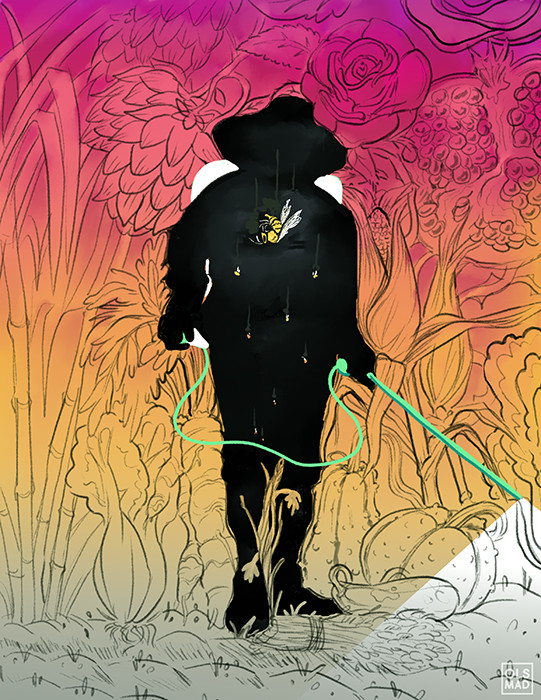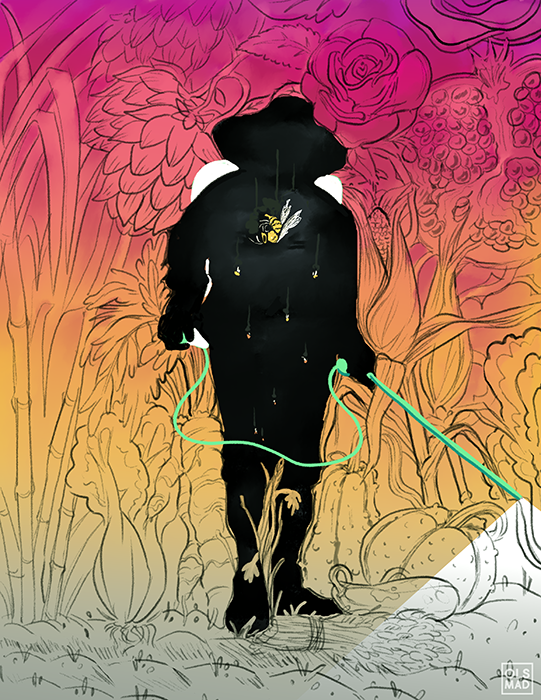
Beekeeper Beth Conrey cannot remember a time during her 20-year career when neonicotinoids — a group of pesticides used widely in industrial farms and backyards alike — were not adversely affecting Colorado’s bee population.
“There’s never been a point where I’ve been in this business and they’ve not been a factor,” she said. Accordingly, Conrey is supporting a campaign by Environment Colorado to rid the state of these pesticides. Canvassers will traverse the state this summer, educating Coloradans about the importance of bees to the agricultural system and the risks neonicotinoids present. Their goal? Building support for an eventual ban on the pesticides.
Conrey is not your average neighborhood beekeeper. She owns Bee Squared Apiaries, a 100-plus colony operation based in Berthoud, and founded a group called the People and Pollinators Action Network. She has given TEDx talks on how global biodiversity and food production are connected to a healthy bee population. Neonicotinoids, which until recently were commonly sold at major garden centers, have been problematic since they were first marketed in the mid-1990s, she said, even though they were touted as a safer alternative to the other pesticides on the market.
Environmentalists argue neonics, as they’re commonly called, are deadly to insects, birds, bats, and other animals essential for pollinating the world’s fruit, vegetables, seeds, and nuts. One issue, they say, is that neonics often are applied directly to seeds or sprayed in a manner that permeates even a plant’s pollen and nectar, thus increasing the odds of exposure for pollinators. The most effective solution, critics assert, is to limit the availability of neonics altogether.
“Banning them is a step in the right direction,” said Adair Andre, a campaign director for Environment Colorado.
But agriculture experts say the hype over banning the pesticide might be overblown.
“This effort is driven more by emotion than science,” said Thia Walker, a pesticide specialist at Colorado State University. “A lot of the studies being cited to support this [ban] are based on a lot of bad science.” Those concerned about the pesticides, Walker said, should be just as concerned about extreme weather and disease-transmitting mites.
Walker’s argument is echoed by the pesticide industry. Bayer, a giant in the neonics market, has vehemently challenged studies that blame neonics for widespread bee deaths. On its website, the company asserts that “no adverse effects to bee colonies were ever observed in field studies at field-realistic exposure conditions.”
Recent studies are yielding other conclusions, though. One study from Canada suggests that bees die from pollinating both neonic-treated crops and plants downstream that absorb neonics in runoff. Another study tracking bees across Europe found that the insects not only died at higher rates near crops sprayed with neonics, but they also struggled to reproduce.
In Colorado, the canvassers feel it’s best to err on the side of caution for the bees.
“Bees pollinate … 90 percent of the world’s food supply — from peaches and avocados to almonds and tomatoes,” Andre said. “Without enough bees, we will not have a diverse and stable food supply. So, the bottom line is that no bees means no food.”
A survey by the Bee Informed Partnership found that 37 percent of U.S. bee colonies died off last winter, the highest rate on record. Wild bees are struggling, too. Colorado is home to more than 950 species of bees, many of which are native, making the Rocky Mountain State among the highest in bee diversity.
Environment Colorado’s canvassers will go door-to-door in Boulder, Vail, Aspen, Denver, and other Colorado cities to garner public support for limiting the use of neonics. Canvassers will engage growers about pesticide use at farmer’s markets, and they’ll meet with lawmakers in the hope that, next year, a bill banning neonics for consumer use will be introduced.
“We believe that Coloradans care about this issue,” Andre said. “We’re working to offer solutions.”
If the campaign for legislation is successful, Colorado would join Maryland, Connecticut, and Vermont in limiting the availability of these pesticides. The European Union enacted a near-total ban on outdoor use of neonics last year, and just last month, the Environmental Protection Agency canceled the registration of 12 neonicotinoid-based products.
Colorado farmers sell more than $6.7 billion in commodities each year, so it’s not surprising that the state is considering neonics limits. Other Western states are doing the same. Lawmakers in Oregon heard testimony in March on a set of bills that would require a state-issued license to use the pesticides (neither measure advanced beyond committee hearings). Last year, the California Department of Pesticide Regulation announced that it would no longer consider applications for expanded use of neonics. Additionally, several large retailers such as Home Depot, Costco, and Walmart have pledged to phase out products containing neonicotinoids.
Some environmental advocates, however, are worried these measures won’t thwart a crisis. “The science world is getting it done, releasing the data showing that [neonics] are harmful to bees and all insects,” Conrey, the beekeeper, said. “This is about big business, money and power. There’s a lot of money being made by the sale of these harmful chemicals.”
Many farmers would argue, though, that ditching the pesticides could have an even greater impact on their yields. “They value [neonics] because it gives them systemic protection from pests as the plant grows,” Walker, the CSU extension specialist, said.
Although legislation to get these pesticides off store shelves is the ultimate goal of Environment Colorado’s campaign, Andre said she hopes education will be enough to convince consumers and local farmers to stop using neonics.
Conrey’s advice for the no-neonic gardener? “Don’t use anything — just let nature take care of it,” she said. “We’ve got to get out of this belief that all bugs are bad. That’s not true; they all serve a greater purpose in our ecosystem.”
This story has been updated to correct a quote from Adair Andre.

